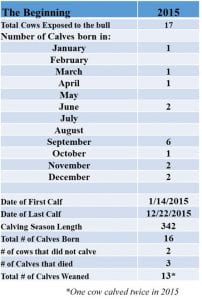– Dr. Les Anderson, Extension Beef Specialist, University of Kentucky
Have you ever looked at your cow-calf operation and had the thought “Geez, what a mess?!” Even if we don’t want to admit it, often our lack of organization and planning sometimes really hinder our opportunity to succeed especially in our cattle operations.
An example; it’s September. Have you pulled your bull? If a bull pen is not available, is your breeding season over? The first step in becoming an efficient, profit-possible operation is controlling the calving season.
How do we transform the calving season? A great example of controlling the calving season occurred on a farm enrolled in the UK Farm Program. This producer had huge Limousin-cross cows (1700-1800 pounds), calved all year long (see table The Beginning), 16 of 17 cows calved and 13 calves were weaned from 2015 calvings. This producer wanted to move to a fall-calving herd because of his time commitments to his grain enterprise.
Steps taken:
- Determined the reproductive status of the herd; he had calving dates and we estimated the date of their next calf by rectal palpation.
- Evaluated the physical characteristics of the cows (feet/legs, udder quality, age, temperament) and developed a plan. The cow that calved in January 2015, was pregnant and calved in December 2015, so one cow weaned two calves from 2015 calvings. She was culled after she weaned the second calf.
- The bull was sold.
- Cows calving from March – October were held for fall breeding.
- 3 cows that did not wean a calf and three “done” cows were sold.
- Two heifers bred to calve in September were purchased.
- One of the November-calving cows was kept and we advanced her breeding by inserting a CIDR device for 7 days about 14 days after she calved.
- Estrus was synchronized for AI in the two heifers and 10 remaining cows. In general, the cow herd was too big so proven AI sires moderate in size, acceptable in calving ease. Developed a crossbreeding plan.
- Heifers were vaccinated against BRD using a modified-live vaccine and boosted about 30 days before breeding. Cows vaccinated using a killed-virus about 30 days before breeding. All females were also vaccinated against Lepto including hardjo-bovis.
- Dewormed all females at the time of vaccination.
- Began feeding the IRM mineral.
- Body condition score was 5+ at calving in all females so the nutrition program was not changed.
 The transformation of this farm was remarkable. The calving season was reduced to 60 days or less and this short season has been maintained. The herd pregnancy rate has been good but some of the cows have been aborting so an additional vaccination against BRD and Lepto at weaning will be added. Several replacement heifers were kept (2 in 2015, 5 in 2016, 7 in 2017, 7 in 2018) to increase stocking rate and to enable culling of the older, bigger, less productive cows. Open and “done” cows were sold each year. We used AI to get predictable genetics and to make crossbreeding easier. About 50-75% of the herd conceived to AI each breeding season.
The transformation of this farm was remarkable. The calving season was reduced to 60 days or less and this short season has been maintained. The herd pregnancy rate has been good but some of the cows have been aborting so an additional vaccination against BRD and Lepto at weaning will be added. Several replacement heifers were kept (2 in 2015, 5 in 2016, 7 in 2017, 7 in 2018) to increase stocking rate and to enable culling of the older, bigger, less productive cows. Open and “done” cows were sold each year. We used AI to get predictable genetics and to make crossbreeding easier. About 50-75% of the herd conceived to AI each breeding season.
Just think about how much more efficient, how much easier this management system is now. This producer has to monitor calving for 50-60 days increasing the opportunity of a higher calf survival rate. Winter feeding is easier and more efficient because the cows are on the same production cycle. Controlling the calving season has helped increase the total pounds of production and the pounds of calf weaned per cow exposed. Even though this producer is only marketing 15-20 calves per year, he was able to put together two marketing groups and increase the market value of his calf crop.
The key to this transformation was a little planning. Once the problems were identified, a plan was developed and then implemented. A solid plan helped control the calving season increasing production efficiency on this farm.